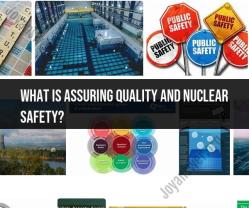What is assuring quality and nuclear safety?
Assuring quality and nuclear safety refers to the practices, protocols, and systems put in place to ensure the safe and reliable operation of nuclear facilities and the prevention of accidents or incidents that could lead to radiation releases or other safety risks. This is of paramount importance in the nuclear industry, where even minor safety lapses can have significant and far-reaching consequences.
Key considerations in assuring quality and nuclear safety include:
Regulatory Compliance: Compliance with stringent national and international regulations and standards is critical. Regulatory bodies, such as the Nuclear Regulatory Commission (NRC) in the United States, set requirements for nuclear safety, and facilities must adhere to these standards.
Safety Culture: Establishing a strong safety culture within the organization is vital. This includes a commitment to safety from top management, regular safety training, and the encouragement of all employees to report safety concerns.
Risk Assessment: Conducting thorough risk assessments to identify potential hazards, evaluate risks, and implement mitigation measures is a fundamental step in nuclear safety.
Design and Engineering: The design and engineering of nuclear facilities must meet high safety standards. This includes redundancy in safety systems and the use of fail-safe technologies.
Operational Procedures: Well-defined operational procedures are essential. These procedures cover routine operations, maintenance, and responses to abnormal conditions or emergencies.
Safety Barriers: Multiple layers of safety barriers are put in place to prevent and mitigate accidents. This includes containment structures, emergency cooling systems, and radiation shielding.
Inspection and Testing: Regular inspections, maintenance, and testing of equipment and safety systems are carried out to ensure they function as designed.
Emergency Preparedness and Response: Facilities must have comprehensive emergency plans in place to respond to accidents or incidents. This includes evacuation plans, communication protocols, and coordination with local authorities.
Radiation Protection: Strict radiation protection measures are implemented to limit radiation exposure to workers and the public. This includes the use of shielding, protective clothing, and monitoring equipment.
Waste Management: Safe disposal and management of radioactive waste are essential to prevent environmental contamination.
Security: Nuclear facilities are also vulnerable to security threats. Ensuring physical and cyber security is a critical aspect of assuring nuclear safety.
Continuous Improvement: A culture of continuous improvement is important. Lessons learned from safety incidents or near misses should be used to enhance safety measures.
Transparency and Communication: Open and transparent communication with the public and stakeholders about nuclear safety issues is crucial for building trust.
Assuring quality and nuclear safety is a multifaceted and ongoing process that requires the commitment of all stakeholders involved in the nuclear industry, from operators and regulators to the public. The goal is to prevent accidents, protect the environment, and safeguard public health while harnessing the benefits of nuclear technology.
Assuring Quality and Nuclear Safety: An Introduction
Nuclear safety is the highest priority in the nuclear industry. Nuclear facilities must be designed, constructed, operated, and decommissioned in a way that minimizes the risk of accidents and protects the public, workers, and the environment.
Quality assurance (QA) is a systematic approach to ensuring that nuclear facilities and activities meet the highest standards of safety and reliability. QA encompasses all aspects of the nuclear lifecycle, from design and construction to operation and decommissioning.
The Role of Quality Assurance in Nuclear Safety
QA plays a vital role in nuclear safety by ensuring that nuclear facilities and activities meet the following requirements:
- Compliance with regulations: QA programs must comply with all applicable nuclear safety regulations.
- Safety standards: QA programs must implement and maintain safety standards that are commensurate with the risks associated with nuclear facilities and activities.
- Continuous improvement: QA programs must continuously review and improve their processes to ensure that they are effective in preventing accidents and protecting the public.
Quality Assurance Practices in the Nuclear Industry
There are a number of QA practices that are commonly used in the nuclear industry. These practices include:
- Document control: QA programs ensure that all important documents, such as design drawings, procedures, and records, are properly controlled and managed.
- Training and qualification: QA programs ensure that all personnel who work on nuclear facilities and activities are properly trained and qualified.
- Inspections and audits: QA programs include regular inspections and audits to ensure that nuclear facilities and activities are in compliance with regulations and standards.
- Corrective action: QA programs require organizations to identify and correct any non-conformances with regulations and standards.
Ensuring Safety and Quality in Nuclear Operations
Nuclear operators have a primary responsibility to ensure the safety and quality of their operations. This includes implementing and maintaining a comprehensive QA program.
Nuclear operators also have a responsibility to report any safety-related incidents or events to the regulatory authorities. This helps to ensure that the lessons learned from accidents and incidents are shared with the industry and that corrective actions are taken to prevent similar events from happening in the future.
Regulatory Oversight and Standards in Nuclear Quality Assurance
Nuclear safety regulators play an important role in ensuring the quality of nuclear facilities and activities. Regulators typically establish QA standards and requirements, and they conduct inspections and audits to verify that organizations are complying with these standards and requirements.
International organizations, such as the International Atomic Energy Agency (IAEA), also play a role in developing and promoting QA standards and practices in the nuclear industry.
Conclusion
Quality assurance is essential for ensuring the safety and reliability of nuclear facilities and activities. By implementing and maintaining effective QA programs, nuclear operators can help to protect the public, workers, and the environment from the risks associated with nuclear power.


